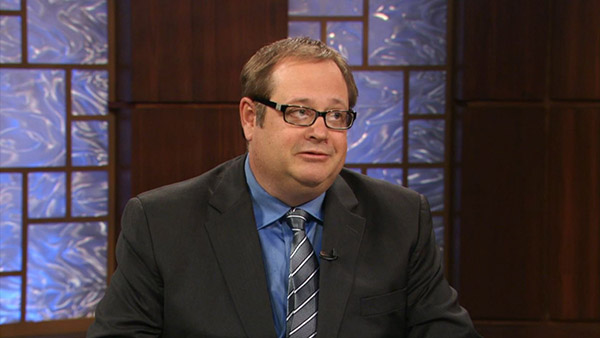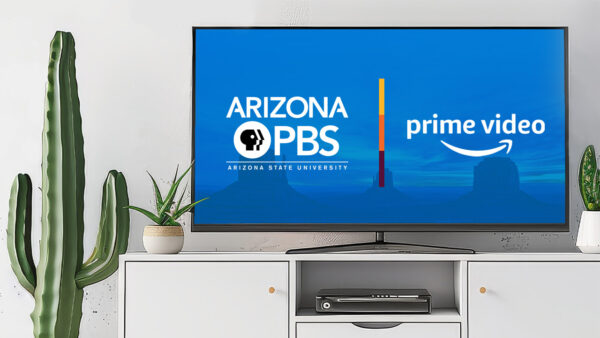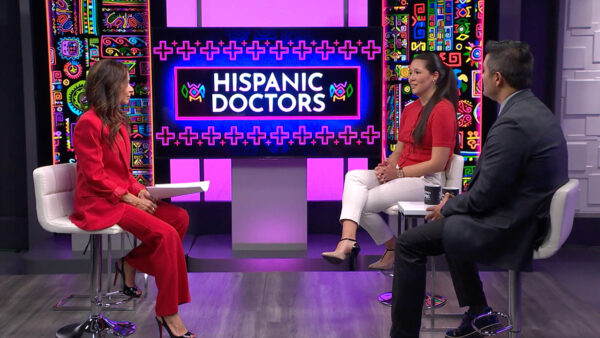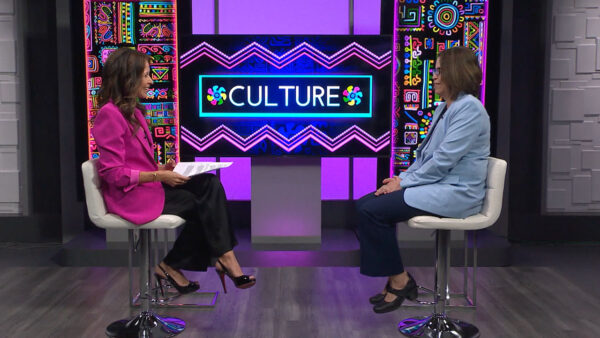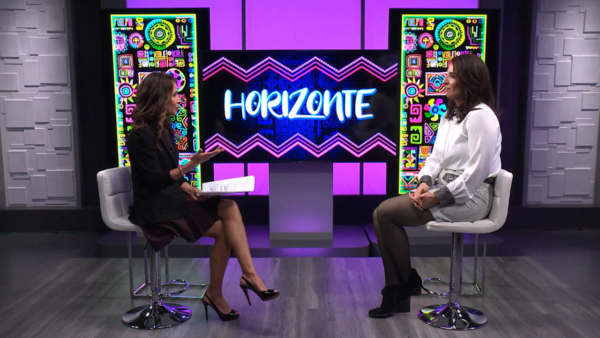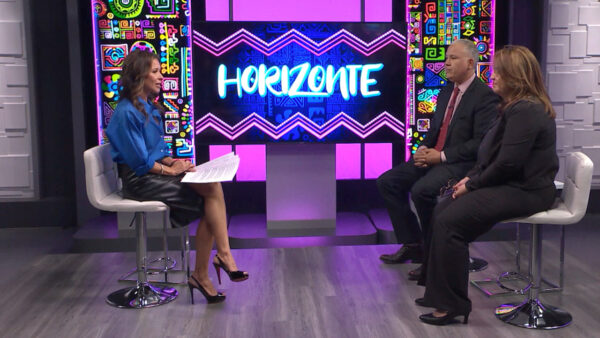Inspired by the growth of Valley Hispanic businesses, a group of Latino leaders is forming a bank to focus on the Hispanic bilingual market. There is a national trend of Hispanic entrepreneurs organizing Hispanic focused community banks as well as larger banks trying to get this growing market. Sonoran Bank will be the first new bank in Arizona to specialize and focus on the needs of small and growing Hispanic-owned businesses. The bank is expected to open in early 2005. Guests include Ricardo Torres, Chairman of Sonoran Bank and Ernie Garfield, Interstate Bank Developers, Inc.
>> José Cárdenas:
Good evening, I'm Jose Cardenas. Welcome to "Horizonte." What do Latinos and American pop culture have in common? The editors of a project will tell us what that connection is. And Hispanic marketing is catching the interest of many businesses, including the banking industry. Now there's a plan to open a Hispanic-focused bank in Arizona.
A group of Arizona State University professors has spent three years on a project. It's a new encyclopedia that shows the impact of Latino roots on American pop culture. It's called Encyclopedia of Latino Popular Culture in the United States. Joining us from ASU are professor Cordelia Candelaria, chair of the Department of Chicana and Chicano Studies. Dr. Candelaria is the general editor and director of the project. Also here is Peter Garcia, assistant professor at the Chicano and Chicana Studies Department. Dr. Garcia is a senior specialist editor in the project. Thank you for joining us tonight on "Horizonte." Dr. Candelaria, we talked about a group of professors, but it really was a team effort from across a variety of disciplines; is that right to put this together?
>> Cordelia Candelaria:
Yes, indeed. The core group, the core team is here at ASU, and we're very pleased with that, and as you describe, I'm the general editor. My colleague, Peter Garcia the senior specialist editor on music, folklore and he can say more about that. One of our former colleagues who was also part of the core team. Arturo Aldama is at the University of Colorado. It was Arturo's involvement early on and desire to do an encyclopedia that got us all started. A project of this size and scope with basically thousands of pieces of information --
>> José Cárdenas:
It's in two volumes.
>> Cordelia Candelaria:
Two volumes, 800 pages. It does require a team effort. The contributors come from universities and campuses, not only throughout this country but also in other countries as well. We sent out a call for entries, and people responded with great interest in wanting to write for us. So we have approximately 125 contributing writers, and we had to sort of organize that material among those people
>> José Cárdenas:
Before we go on to specifics of the book, Latino influence, American pop culture, how long does that date back?
>> Cordelia Candelaria:
It goes back a long time. If you think about popular culture, popular being the people, the populace, that goes back to the first contact of the European and the indigenous people, because the heritage of Latinos is that first contact and the resulting exchange that happened from Spanish languages, indigenous languages, food, the fact that tomatoes were native to the western hemisphere and the native peoples used them in particular ways in Mesoamerica and South America, but when they went to Europe with the Esapanolas and Italians, they took on a whole other flavor. Some people think tomatoes originated in a ketchup bottle or can of tomato paste. So, what I am saying is that original kind of popular culture goes back to the very beginning.
>> José Cárdenas:
Hundreds of years.
>> Cordelia Candelaria:
Yes.
>> José Cárdenas:
This is a serious academic work. What did you find in your research that is of particular interest?
>> Cordelia Candelaria:
There is so much that is there, but I would mention a couple of things that are perhaps my hobby horses and I'll let Dr. Garcia, Peter, talk about his, but certainly the one thing that I think is important as one looks at the popular culture, just taking food, for example, or music, or poetry or religious spirituality and healing. When we researched that, we discovered that in fact that has a strong basis in the past, actually, going back to the conquest, 1492, Columbus' voyages and the conquest in 1521, and what we find is from the very beginning, there was a mix, there was a hybrid. I think that's a powerful piece of information, particularly because that mix happened early in Mexico, New Spain, but then it continued on into the Southwest and the United States as it is today, and that mix continues. So that when we talk about what's American culture, it really is that mix of the Spanish, the Indian, the African, because of course, there were Africans on Columbus' ship, there were Africans here in the Jamestown colony, and, of course, there were the Europeans from England and from Spain, and so that mix goes back to the very beginning. And what we see in the popular culture, the art, the literature, the paintings, the food, is evidence of that mix. I can't speak about it as eloquently and as informed as my colleague Peter, but when he talks about mariachi music is a hybrid of both the European and the mestizo, that suggests how far back it is. I think that's an important part of information to take back. As an American, I value the paternity of George Washington, and I hope that someone whose last name is Washington might value the paternity of say Christopher Columbus and all of the rest of those. So it's that kind of a mix, going way back in the culture.
>> José Cárdenas:
Dr. Garcia, we've given you quite a buildup. I don't want to put too much pressure on you, but what did you find out about the artist styles as they compared between American and Latino culture?
>> Peter Garcia:
I think the basic idea behind it is the mixture of very different musical traditions coming together in particular time, like say New York City, the Latin jazz phenomenon that put out so many incredible musicians and led up to the present, you know, with Ricky Martin and J. Lo. It has a long tradition. It didn't suddenly happen.
>> José Cárdenas:
And mestizar refers to the mixing of the Spanish and Indian bloods, but you are referring generally to the mix of Latino and American culture.
>> Peter Garcia:
Absolutely, and the new mestizara that's taking place today. Really interesting hybrids, country western and mariachi, mixing traditions that you would never think would come together and bringing really interesting, creative results.
>> José Cárdenas:
The book focuses principally on Mexican, but it covers the whole range of Latinos in the United States. Tell us about that.
>> Peter Garcia:
Well, we tried to organize the book according to the demographics of the United States, and since Mexican Americans or Chicanos are the largest group, 60% of the book is focused on the popular culture of that group, but we also have about 12% on Cuban Americans and 12% on Puerto Ricans and even some things on South Americans.
>> José Cárdenas Jose Cardenas:
Is there a definition that you can give us of Latino pop culture?
>> Peter Garcia:
Definitions are varied and there are many, many definitions of popular culture. But, you know, we kind of debated and argued and really came up with no one particular definition in particular, but -- I'll throw that back in your court.
>> Cordelia Candelaria:
I suppose the catchiest one that actually captures it and that is -- gives you the definition is -- it's everyday activities of the people, and everyday activities include such things as food and cooking and religious beliefs and folklore and fiestas, festivals, quinceaneras, but it also includes in terms of the commercial sense of pop culture, it is now included sort of the mass celebrities, the movie stars, the television stars, the Desi Arnezes and the Ricky Martins and the folks who have been more celebrated, Martin Sheen, for example. And so that popular --
>> José Cárdenas:
Martin Sheen is Hispanic. I don't think people realize that.
>> Cordelia Candelaria:
Martin Sheen is Hispanic. We have several Sheens in the book, but they are not under Sheen, they are under Estevez, which was his original name. So what the book does is talk about every day practices that people engage in, and that are passed on from generation to generation, and the popular culture of commerce is also in the book.
>> José Cárdenas:
In what way?
>> Cordelia Candelaria:
Well, the popular culture of movie stars, of sports stars, of the singers, the Freddie benders. We have the mariachis as we described. We have particular entries on them, but we have the poets. We have the artists. And so what we've tried to capture in the book is to take the definition of popular culture that is the -- sort of the layperson in the street definition, which usually focuses on what comes out on television and the movies, and we've used a more academic definition of popular culture studies, which includes that, but doesn't limit it to that.
>> José Cárdenas:
If we're talking about personalities, historically, how far back does the book go? The 50s? The '60s or are we talking several hundred years ago?
>> Cordelia Candelaria:
Our chronology goes back to the beginning, to the crossing from the across the bettering straight. We try to suggest that because we want to suggest -- we know that Latino popular culture to be understood needs a context. And so we want to provide that context. So we started at that point, but most of the A to Z entries, A to the very end, are about particular people, places, things, events, activities and practices. But we actually go back to the beginning. We have most of the information is 20th century, and I wanted to add on a comment to Peter's discussion of the material in the book is, in fact - it has a large segment about Chicanos, Mexican Americans. It is partly because of the population demographic, but it's because of the heritage and history. Since Mexican Americans were a large part of what is now the United States for a long period of time, from the very beginning, in fact from 1492, we can start dating that, and then the first discovery, journeys north, 1547, 1598, into what we know as the Southwest, and to Florida, the oldest continuous inhabited town is St. Augustine in Florida, and that of course was founded by the Spaniards and began immediately to have that exchange and contact with the Native Americans. So, we -- because of that, there is a large prior heritage and history. And so there are more Mexican Americans by population and there is a longer time. So naturally, when you look at the artifacts, at the practices, at the singers, there are so many Lopezes. George Lopez, Yvonne Lopez, Jennifer Lopez, with due respect, gives us headaches because we have to keep changing the ending on that every single time we've gone to press.
>> José Cárdenas:
Dr. Garcia what was your reaction when you were first approached to be involved in this project?
>> Peter Garcia:
I had no idea what I was getting myself into. It turned out to be a Pandora's box.
>> José Cárdenas:
In what way?
>> Peter Garcia:
As I started talking to colleagues about the project and seeing how excited people were, especially in the academic world, saying, wow, this is a project that is long overdue. Everybody was really supportive and really encouraging, yeah, this is really worthwhile and it needs to be done.
>> José Cárdenas:
Is this a book that would appeal to people who are not of Hispanic or Latino decent?
>> Peter Garcia:
Absolutely.
>> José Cárdenas:
Why is that?
>> Peter Garcia:
Because of the changing demographics, you know, the social interaction that goes object daily, and just -- not just the ignorance amongst Non-Hispanics, but even the ignorance amongst Hispanics ourselves. We teach Chicano studies. It's amazing how little our students know about it.
>> José Cárdenas:
Those people, what would be the most surprising thing they would find if they read this book?
>> Peter Garcia:
History, sports, the impact of Latinos in the forging of an American identity. As Dr. Candelaria said -- and both of us are actually from New Mexico and my ancestors have been here -- my Spanish ancestors have been here since the 1620s, but just to see how historically rooted Mexican Americans have been in the Southwest and Cubans in Florida and Puerto Ricans in New York.
>> Cordelia Candelaria:
If you look at something as American as Donald Duck and Mickey Mouse, we would be surprised, I think. Americans might be surprised to know that Bill Melendez, who is the illustrator and who Walt Disney one time suggested was an indispensable part of his operation in terms of his artistry and his imaging and illustrations for the Disney Corporation, and who did so much of that, the Disney images, he's a Mexican-American.
>> José Cárdenas:
It sound likes there is a lot of interesting information that will be a surprise to awful us. When will the book be out and how will people be able to get a copy of it?
>> Cordelia Candelaria:
People can go to the Greenwood Publishing Group Web site. I thought we had mentioned the press - we could have said that. It's being published by Greenwood Publishing Group in Westport, Connecticut. If they go to the Web site, www.greenwood.com, they can see the prepublication order and it will be released in October. It'll be on the shelves in October, and released in late September.
>> José Cárdenas:
I'm sure it will be a great success. Thank you for joining us on "Horizonte."
>> Peter Garcia:
Thank you.
>> Cordelia Candelaria:
Thank you for having us.
>> José Cárdenas:
With the growth of Hispanic businesses in Arizona, there is a need to access capitol to grow businesses. Hispanic-owned and operated financial institutions are in business in Hispanic communities across the country. There is a plan to bring a Hispanic-focused bank right here in the Valley.
>> Reporter:
The U.S. Census Bureau estimates the number of Hispanics living in the U.S. and their purchasing power has sparked an increase in businesses and services targeting the Hispanic market. These approximate figures put Hispanic purchasing power at $600 billion, and estimate that a 50% increase in population since 1990 puts them on track to be the largest minority group in the United States by 2005. These numbers have caught the interest of businesses and entrepreneurs, especially in the banking industry. Only recently have banks began to address minority markets, particularly Hispanics, via bilingual tellers, ATM machines, or acceptance of the Matricula, a government document issued by Mexican government as a means to give illegal immigrants identification that can be used to order accounts. In order to keep up with the growth of Hispanic businesses, a group of Latino leaders are forming a bank to focus on the Hispanic bilingual market. According to Federal Deposit Insurance Corporation statistics, seven total Hispanic-owned banks opened between 2002 and 2003. Sonoran Bank will be the first new bank in Arizona to specialize in the needs of small and growing Hispanic businesses. It's estimated the bank will open in early 2005 and will focus on business loans.
>> José Cárdenas:
Joining us is Ernie Garfield who is helping organize the Sonoran Bank. Also here is Ricardo Torres, chairman of the Sonoran Bank. Thank you for joining us on "Horizonte."
>> Ricardo Torres:
Thank you.
>> José Cárdenas:
Ricardo, give us an overview of the bank.
>> Ricardo Torres:
Right now we have 10 bank directors. We are still forming the board, adding probably two or three more. The bank will be focused on Latino-owned businesses. Of course, all business is good, but this is the first time that a bank here in Arizona has been formed specifically to target the Latino-owned businesses in the state.
>> José Cárdenas:
Ernie, you are a native Arizonan. You've been on the scene for a long time. Give us a little bit more on your background.
>> Ernie Garfield:
All of my life. I was born on the reservation here, and I've lived here all of my life except for military time. And I started putting banks together right after I came out of public office where I had served as a state senator and deputy state treasurer and corporation commissioner, and I've done 26 banks so far.
>> José Cárdenas:
And a fair number of them have been focused on the Hispanic market; is that right?
>> Ernie Garfield:
No, that's not the case. This will be my first one that will have been focused on a Hispanic market.
>> José Cárdenas:
In your past experiences, what has led to you think that a Hispanic-focused bank is appropriate right now?
>> Ernie Garfield:
The dynamics of the economy and the changing marketplace. We have about 28,000 small businesses in Arizona owned by Hispanics at this time, and I've found that small businesses do not get the banking services that they need. At the time, I was state treasurer; about 95% of the banking assets in Arizona were locally controlled. Now it's less than 5%, and subsequently, the small businesses are the ones that are left out, because the decisions are being made by big banks for big businesses, remote from Arizona, and the Hispanics perhaps are even more neglected in that case than the small businesses. Not intentionally, but it has to do with economies of scale.
>> José Cárdenas:
Let me ask you this, Ricardo, why this bank here in Arizona? We have a significant Hispanic population, but you've got California, you've got Texas, why not there?
>> Ricardo Torres:
Well, I think that in those areas, there are Latino-focused banks or Hispanic- owned banks already being formed or have already been formed.
>> José Cárdenas:
How long have they been in business?
>> Ricardo Torres:
The history of the banking or you know banks that specialize in Latino-owned businesses, there is some in Miami, some in Florida, one from Puerto Rico came to the United States and has been hugely successful, and has been focused only on the Hispanic community.
>> José Cárdenas:
Have there been any failures?
>> Ricardo Torres:
I'm going to let our bank consultant answer that.
>> Ernie Garfield:
Yes, in the past, there was an attempt to focus on minorities, not only Hispanics, but on women minorities and black minorities, and many of those banks fail simply because they were started with the wrong concept in mind. They weren't, perhaps, solidly founded as they are now days.
>> José Cárdenas: Wrong concept in what sense?
>> Ernie Garfield:
Well, for example, we've had our strategic planning sessions lately, and the board that we have is a tremendous board that is concerned about doing something for the Hispanic community. So the first thing they want to do was look at how do we bring people in who are unbanked? How do we educate them so that they can become part of the process and benefit from the economic growth in this country? And it's wonderful to feel that way and ultimately that's what we'll do, but in the first step is to go make money so that you can then have educational programs and bring the rest of that community in.
>> José Cárdenas:
How will you do that? I've heard people commenting on this venture, which has received a fair amount of publicity in the press, in pointing out that it costs as much to process a $5,000 loan as it does a $100,000 loan, and there is some questions about whether this bank will succeed. How do you respond in that regard?
>> Ricardo Torres:
Well, there are a lot of things about the bank as far as how you run the bank and what you do with the bank, what kind of services that you provide, and those are some of the things that we're analyzing now. One of the things that we're doing right now is that we're talking to Latino-owned businesses, and we're trying to get a feel for what the needs are that are out there. There's a questionnaire that went out to over 9,000 Latino-owned businesses. We're getting the results of that back.
>> José Cárdenas:
The focus will be on businesses as opposed to individual customers?
>> Ricardo Torres:
Yes, the focus will be on businesses, and we're getting this information back and we're finding out what the needs are, how we can fill those needs, and then tailoring bank products around them.
>> José Cárdenas:
What would distinguish your efforts from those of Bank of America, Wells Fargo, Bank One, all of which have Hispanic market-focused efforts?
>> Ricardo Torres:
I think the Hispanic market efforts of all of the banks that are currently in existence have been terrific. They've done a terrific job of focusing on the consumer. This is the first time that a bank will strictly focused on Latino-owned businesses.
>> José Cárdenas:
Ernie, how successfully do you think a bank of this focus can compete? Presumably they would want this business as well.
>> Ernie Garfield:
Really, they don't. See, that's the mistake most people make. They think because a bank is a bank, that it has the same type of products and services and market as another bank, but your point about the cost of the $5,000 loan is right at the heart of this. The big banks like to make multi-million dollar loans, because it doesn't cost them any more to monitor a multi-million dollar loan than it does a $100,000 loan. With us, we're structured differently, and we will be in a position to make it cost effective to monitor a $100 thousand loan, a $25,000 loan, or a $250,000 loan. It's just the way we process things, and as I said, I've done 26 of them, and while the others have focused on small businesses, and this will be the first one focusing on small Hispanic-owned businesses, as well as other businesses, too, and it's not going to be any different in that regard, except that we're going to be personalized. We're going to take the business to these folks. We're going to have courier service. We're going to be part of the ATM -- automatic machine network -- through Wells Fargo and Bank of America where people can go to those banks and make deposit was us.
>> José Cárdenas:
It'll be a full-service bank, then?
>> Ernie Garfield:
Except for the trust department and then we'll refer those folks out to a correspondent.
>> José Cárdenas:
Ricardo, you've made it a point to talk about the board and Ernie, you've indicated that's significant, too. Why is that?
>> Ricardo Torres:
Because of the experience that the board brings to the table, the experience in the community, the history with the community. We have business people on the board that have a long history of doing business with Latinos. We have people on the board from the nonprofit world that have a long history of working inside the community and making a difference. I think that this particular characteristic of our bank will really distinguish us from other banking institutions that have tried to come in to the market.
>> Jose Cardenas:
Ernie, kind of the same question to you. Based on your experience with 26, I think you said, startup banks, why would the board be that significant?
>> Ernie Garfield:
The board is the foundation. If you don't put the correct board together, the bank will not succeed, and that's part of the reason why some of these banks in the past have failed where people that were well-meaning and perhaps not as deep-rooted in the area came together and happened to raise the money and started a bank. And a few years later, they perhaps failed for a number of reasons. Now, in the case -- we take a lot of time putting a board together. I want to make sure that the people who come to the table know what they are getting into, knew who they were getting involved with, understand the depths of the commitment that they are making. I want to make sure they have deep roots in the area, that they have centers of influence, and assembling the board is probably the most critical thing that I helped the group do. Anybody can put a bank together, and I do have great technicians who do that part of the work. But my job, primarily, is to make sure that we have the right people, compatible people sitting at the table, and that we hire the right president, and then we end up with the right strategic business. In my opinion, this is going to be my premier bank.
>> José Cárdenas:
That sounds like quite a challenge for you Ricardo to satisfy. You are still in the process of finalizing the board and selecting your president, as I understand.
>> Ricardo Torres:
That is correct.
>> José Cárdenas:
When will the bank be operational?
>> Ricardo Torres:
We project the bank will be operational in early '05. There is still a lot of work to be done, a lot of preparations to do. The strategic plan is being put together. We've had several meetings on that already. The president has not been selected. We're starting the search for that now. So the people who will actually be running this bank will be bankers. They won't be --
>> José Cárdenas:
Final thoughts on what this bank will look like 10 years from now
>> Ricardo Torres:
We haven't gone that far. Three years from now --
>> Ernie Garfield:
I would say within three to five years we'll be in $135 to $150 million.
>> José Cárdenas:
We'll have to leave it at that. Best of luck on this venture. We look forward to your continued success. That's all for us tonight. Thank you for watching. Join us next Thursday on "Horizonte." I'm your host, Jose Cardenas. Have a good night.
Peter Garcia: Assistant professor, Chicano and Chicana Studies Department, Arizona State University;
